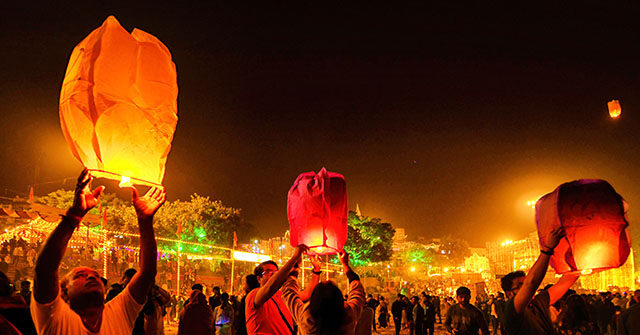On Diwali, the Festival of Lights celebrated by millions, former President Donald Trump positioned himself as a protector of Hindu Americans, using this festive occasion to address the Indian American community. In a message shared on his social media platform, Truth Social, Trump criticized the current Democratic leadership, blaming Vice President Kamala Harris and President Joe Biden for violence against Hindus in Bangladesh. He characterized their foreign policy as chaotic, linking it to increased persecution of Hindus in regions affected by destabilization. His words were a direct appeal to Indian Americans, a crucial voting bloc with shifting political affiliations, as many within this diverse community appear to be reconsidering their traditional Democratic allegiance.
Trump framed his message in a context of urgency and concern for Hindu safety, particularly in Bangladesh, where riots and political unrest have led to violence against religious minorities in the wake of the prime minister’s abrupt resignation. The situation in Bangladesh has resulted in significant casualties and damage to properties aligned with religious minorities, presenting a backdrop of disorder that Trump claims is exacerbated by the Biden administration’s failings. Trump’s condemnation aimed to resonate with the fears and frustrations of Indian Americans, highlighting a broader narrative that positions him as a champion of their rights and interests.
In appealing to the Indian American voter base, which encompasses a wide demographic spectrum, Trump highlighted the community’s concerns about issues that have become increasingly central to their political engagement. Recent polling indicated that inflation emerged as the paramount issue for Indian Americans, eclipsing concerns like abortion. Trump capitalized on these sentiments by positioning himself as a pro-business and anti-regulation candidate, contrasting his policies with those of Harris, whom he claimed would impose higher taxes and stifling regulations. Such rhetoric reflects an understanding that economic issues are pivotal in swaying voter allegiance within this group, especially as the community navigates challenges in their business ventures and broader economic participation.
Historically, Trump’s administration had a pro-Indian foreign policy, which favored strengthening ties with Prime Minister Narendra Modi and addressing the threat posed by China. This aspect of Trump’s political legacy finds resonance among Indian American voters, many of whom view it positively. However, the duality of their political identity is evident in their recognition of Kamala Harris, who represents a significant milestone as the first Indian American vice president, revealing a complex interplay between national identity and party loyalty. Many Indian Americans appreciate Harris’s representation, even as frustrations grow regarding Democratic policies that they perceive as unfavorable, particularly regarding immigration.
Trump’s Diwali message concluded with wishes for peace and prosperity, aligning closely with the festival’s themes. The celebration of Diwali itself, reminiscent of triumph over adversity and the victory of light over darkness, echoes within the cherished cultural narratives of the Indian American populace. With 2.6 million eligible voters, Indian Americans are an influential constituency for the upcoming presidential elections. Recent polling shows a notable change, with a decline in Democratic identification among this group, raising the stakes for both parties in courting their support. Trump’s strategy appears to capitalize on this shift as he seeks to engage Indian American voters directly, particularly through emotion-laden messages on cultural significance.
Amidst the backdrop of the upcoming election, the political landscape among Indian Americans has clearly shifted, evidenced by increasing support for Trump amongst Indian American men, while women in this demographic continue to favor Harris. Polls suggest that Trump’s support has seen a modest uptick compared to previous elections, illustrating a re-alignment in voter priorities that could influence the broader narrative of the 2024 presidential race. Social gatherings, such as Diwali celebrations in metropolitan areas, further demonstrate this divide, whereby influential Indian Americans may rally behind Democrats while grassroots sentiments lean more toward Trump, underlining a significant divide based on socioeconomic status and political philosophy.
As the election approaches, discussions around immigration policies, economic stability, and cultural representation will undeniably shape the political behavior of Indian Americans. The contrasting approaches of Trump and Harris reflect deeper societal debates about the future directions of policy that affect their community. Through a blend of strategic appeals and culturally resonant messaging, Trump aims not only to galvanize his base but to redefine Indian Americans’ place within the larger political spectrum, making them a pivotal group that both party candidates will be keen to engage. The evolving dynamics within this voting bloc underscores the need for any candidate to address their unique concerns, beliefs, and aspirations as they move towards the crucial November 2024 election.

